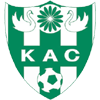
KAC Kenitra
- Leagues Played
- Maroko - GNF 1 104 Maroko - GNF 2 97 Marocký pohár 17
- Links
- Wikipedia
Wikipedia - Kenitra
Kenitra (Arabic: القُنَيْطَرَة, al-qunayṭara, [alqunajtˤira], lit. 'the little bridge') is a city in northwestern Morocco. It is a port on the Sebou River with a population of 431,282 as of 2014. It is one of the three main cities of the Rabat-Salé-Kénitra region and the capital of the similarly named Kénitra Province. During the Cold War, the US Naval Air Station Port Lyautey served as a stopping point in North Africa.
History
Ancient history
The history of the city begins with the foundation of a trading post by Carthaginian explorer Hanno. It was known back then as Thamusida.
Colonial and recent history
In March 1912 the French government and the Sultan of Morocco, Abd al-Hafid, signed the Treaty of Fez. Because of his growing unpopularity, the Sultan asked the French government for protection against the Berber rebel tribes surrounding Fez. France appointed Hubert Lyautey resident-general in Morocco.
General Lyautey restored peace and order to the country after crushing the tribal uprising. After safely moving the Sultan from Fez to the current capital city, Rabat, Lyautey began his task of civilian administration.
One of the first preoccupations of General Lyautey was to build ports along the inhabitable Atlantic coast where there were no natural harbors. He established Port Lyautey in 1912 as a French military fort and town. Its port, at the mouth of the Sebou river, was opened in 1913. It soon became the best river port in Morocco. Kenitra draws its name from a culvert built at Fouarat lake upstream of the kasbah. This culvert was destroyed in 1928. In 1933, the French officially named the locale "Port Lyautey".
It was renamed "Quneitra" in 1956 as Morocco gained its independence. The city has grown rapidly to be a shipping centre for agricultural produce (mainly fruit), fish, timber, and lead and zinc ores. The city's industrial area lies upstream of the port.
U.S. Naval Base
In November 1942, after Operation Torch, the Americans captured the Port Lyautey French fighter base as a military base, named Craw Field. For three months the 21st Engineer Aviation Regiment worked on the airfield. In February 1943 the Seabees of the 120th Naval Construction Battalion took over all construction activities. The Navy ran the base until 1947, when the State Department negotiated reversion of control to France. In 1950, a $23,000,000 expansion was authorized, but then the Korean War diverted resources. In the 1950s, nearly 10,000 people were on the base making it the largest aggregation of Americans in any one overseas base outside Japan. Later, the base in Kenitra was expanded to become a U.S. Naval Air Station.
The base was shared by both the US and Morocco through the Cold War. A small Navy communications out-station in Sidi Yahia closed in the late 1970s. The Air Station was closed in 1991.
KAC Kenitra je jedným z najúspešnejších klubov v Maroku, vyhral majstrovstvá 4-krát a Coupe du Trône 6-krát. Klub reprezentoval Maroko v niekoľkých medzinárodných súťažiach, vrátane Ligy majstrov CAF a Pohára konfederácií CAF.
V súčasnosti hrá KAC Kenitra v Botole Pro, najvyššej marockéj futbalovej súťaži. Trénerom tímu je Abdelhak Benchikha a medzi jeho najznámejších hráčov patrí brankár Anas Zniti, obranca Ismail El Haddad a útočník Ayoub El Kaabi.
KAC Kenitra je známy svojimi silnými fanúšikmi, ktorí sú známi ako "Ultras 96". Fanúšikovia klubu sú vášniví a podporujú svoj tím na každom zápase.
Klub má tiež silné mládežnícke systémy a vyprodukoval niekoľko talentovaných hráčov, ktorí hrali za marockú reprezentáciu. Najznámejšími odchovancami klubu sú Noureddine Naybet, Youssef Safri a Marouane Chamakh.